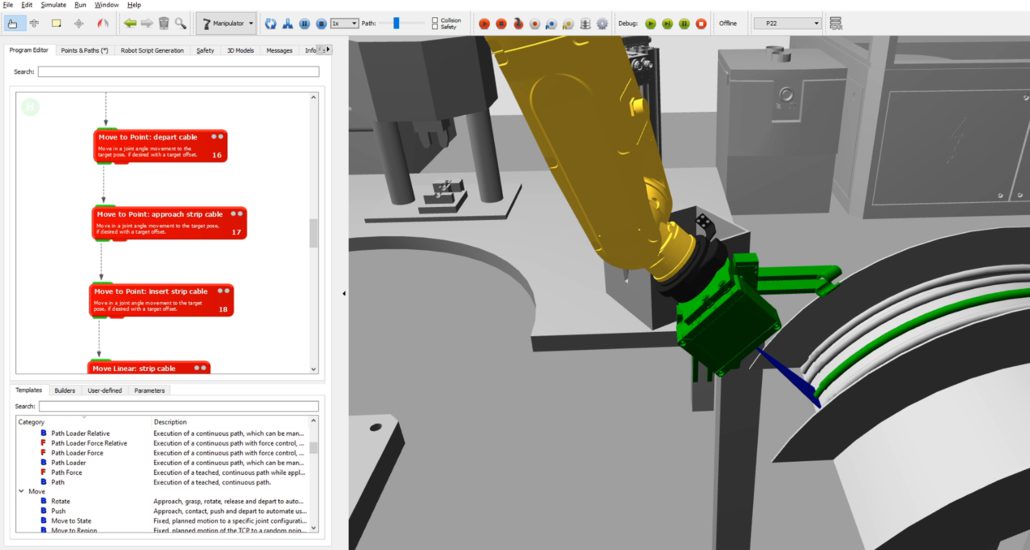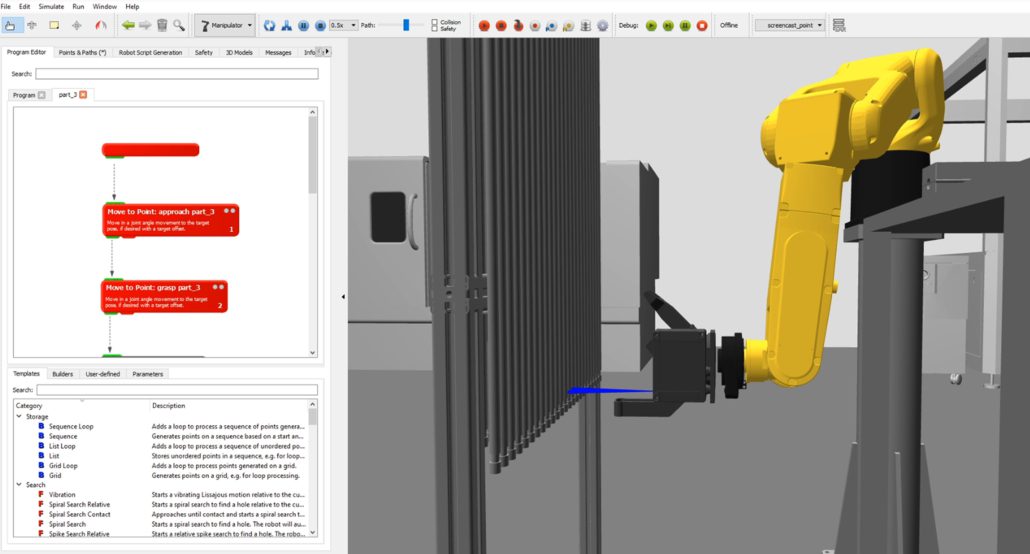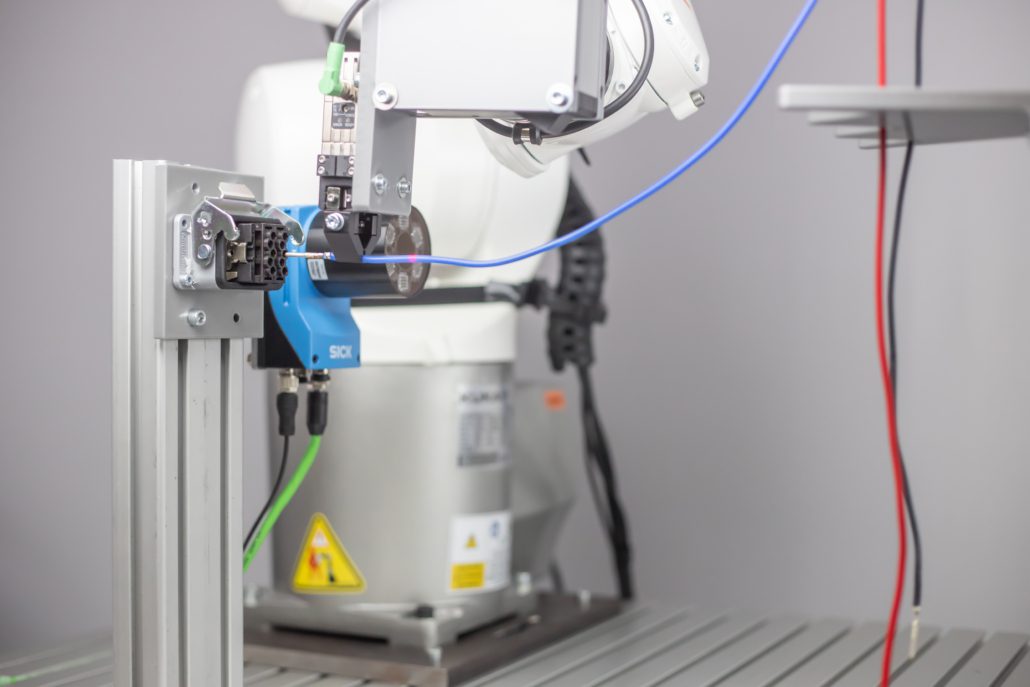AUTOMATED PROCESSING OF CABLES, WIRES OR TUBES USING ROBOTS
Grasping and plugging cables is child’s play! For us humans, yes. However, automated processing of such flexible parts presents robots with considerable challenges. Nevertheless, the potential is huge; in terms of efficiency and quality as well as in terms of relieving employees, for instance when it comes to handling large, heavy cables. What was unthinkable years ago is now possible thanks to the further development of technology, whether it be high-precision measuring using laser scanners, sensitive tolerance compensation using force-torque sensors or smart tools for the robust programming of advanced robotics applications.
The automotive industry is one of the pioneers of automated production. Suppliers as well as manufacturers are always interested in innovative automation solutions. This is because the solutions already in use are mostly special machineries. These solutions are only profitable for large quantities and their use is inflexible. However, the pressure to automate and digitize manufacturing processes is increasing significantly in the automotive sector in particular. High quality requirements, a shortage of skilled workers or the desire to reshore production are three of the reasons. At the same time, cable-processing tasks such as the handling of cables during assembly or the production of small cable harnesses are still a classic case of manual work in many places. Robot-assisted solutions could often reduce this significantly. Nevertheless, it is worth looking beyond the final stage of the production process, which involves plugging wires, cables or connectors. There is great potential hidden one-step earlier, in the cable feeding process.
INCREASING FLEXIBILITY BY USING ROBOTS

Production with flexible robot cells, which contain a high proportion of standard components, is more sustainable. These can be individually adapted to the respective technical requirements and product characteristics. The number of robot cells used can scale production quantities. This applies in particular to the processing of limb parts. In order to compensate for the tolerances that prevail with flexible parts, the robots are equipped with flexibly configurable sensors such as laser scanners, force-torque sensors or smart cameras. Once the robot has specifically grasped the end of the cable, wire or tube, it can flexibly perform various production steps, such as fitting connectors, loading machines for crimping or welding, attaching components to the wire and much more. In order for a robot to be able to grip flexible parts reliably, a number of requirements have to be met. Rainer Jäkel is the CTO at ArtiMinds Robotics GmbH. In recent months, he and his colleagues have implemented projects in various applications in which robots automatically locate, grip and process limb parts. ArtiMinds has developed a laser scanner approach for this in combination with their ArtiMinds RPS programming software. He explains what options there are for feeding, for instance in cable assembly or wire harness production: “Depending on the production environment and the quantities, length and weight of the parts being processed, there are three main approaches that come into consideration: Cutting cables directly from a drum on site, using hanging racks or using special boxes.”
CUT TO SIZE DIRECTLY ON SITE
The more defined a cable or tube is fed to a robot, the easier it is for the robot to grip it. If the material is available on a reel or drum, for example, the gripping point is already sufficiently known. Tolerances arise due to the gripping process itself and properties of the material, such as twist. Once the robot has grasped the cable securely, it is easy to carry out further processing steps. “Of course, this requires vision tools that precisely measure the end of the gripped wire depending on the next processing step, so that the software can determine in which direction the wire sticks out from the gripper or at what angle it should be inserted into another part, for example,” adds Jäkel. Once the cable has been grasped in a defined way, there are many things the robot can do with it. Although the robot does not reach the speed of a classic cutting machine, the ability to integrate additional process steps and thus save time throughout the entire handling process compensates for this in no time. Jäkel reports: “The necessary parameters came together in one of our customer projects: Cutting cables in the system was not a problem, as the process had already been implemented several times. Nevertheless, a large part of the added value was created by the automated, fast assembly of the cable end with integrated quality inspection. This resulted in the development and implementation of an automation solution that was ideally tailored to the customer’s requirements.”
USING HANGING RACKS
For longer cables, the use of suspension racks can be useful. These cables are often not only long, but also thick and therefore heavy, for example in the high-voltage range. The robot therefore often only grasps the end of the heavy cables, while the rest of the cable remains on the suspension frame. The difficult task for the robot is to find the correct gripping point on a freely suspended cable. To do this, the robot uses a laser scanner to scan the end of the cable and determine the ideal gripping point and angle. To ensure that the work is carried out efficiently, such racks are often equipped with many cables and inserted into the robot cell. The robot can now work for a longer period of time without the intervention of an employee until it needs to be restocked. “With this flexible solution, customers can often open up existing machines for automating the processing of cables and thus reduce the necessary investment,” says Jäkel.
CABLES IN BOXES
Cables with a length of up to approx. 1,000 mm are usually best fed in boxes. For automation purposes, the cables are placed in vertical compartments to ensure minimal structuring, which enables the robot with sensors to safely pick up the cables. “The robot solution that we implemented with a customer using this method significantly reduced the time required to prepare the material and thus improved machine utilization,” reports Jäkel. The robot also knows roughly where to expect the cable, then measures it in detail with the laser scanner and accesses it with pinpoint accuracy. After one or more processing steps, it then places the cable back in another box. The advantage of this procedure is that working with boxes is an established standard process that fits in well with the overall production process. It is therefore a particularly suitable approach for brownfield systems.
PROGRAMMING MADE EASY
Regardless which of the three feeding methods is chosen, the user benefits from a robot solution with flexible standard components because the same system or production process can be used to process different cables and integrate additional production processes without major retrofitting work and costly additional developments. Besides the question of a suitable feeding concept, there is also the question of programming the robots and integrating sensors and tools. Especially those who have little previous experience with automation in general or robots in particular are often reluctant to use sensors in combination with robots.
With its Robot Programming Suite (RPS), ArtiMinds is taking a path that makes it noticeably easier to get started with robots using flexible sensors and tools and enables the robot-based automation of advanced applications. With its graphical user interface and predefined templates, robots can be programmed more easily, more efficiently and therefore more profitably without additional hardware. Thanks to suitable interfaces, ArtiMinds RPS ensures the smooth integration of sensors and tools without the need for specialist knowledge for this components or knowledge of the respective robot language. Corresponding templates simplify the scanning, measuring and precise gripping of flexible parts and enable reliable, force-controlled insertion. Jäkel sums up: “In recent months, we have worked with our customers on various projects involving the automated processing of flexible parts in the production of wiring systems or in the white goods sector. We have not only advised on the feeding process, but also provided practical support from the initial automation steps through to actual implementation. It is important to know that we can also integrate innovative partial solutions into existing processes, as ArtiMinds RPS generates native robot code. Our aim as a comprehensive robotics partner is to respond flexibly to our customers’ needs and offer exactly the services and concepts required.”
Cable crimping
Cable insertion
Wire production
Program and simulate robot applications independent of manufacturers, reduce maintenance costs and alleviate the lack of skilled workforces. Find out how ZF succeeds thanks to ArtiMinds!
We answer the most important questions about the ArtiMinds software solutions, applications and the company in our FAQ section.
With this white paper, we want to provide you with guidance for your automation plans. To help you to avoid typical pitfalls when using robots, we highlight the top 5 underestimated challenges and stumbling blocks when getting started in robotics and provide you with helpful tips and interactive checklists.









